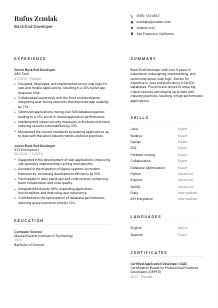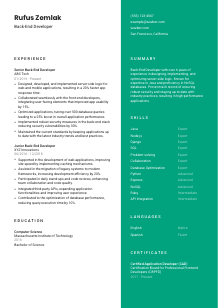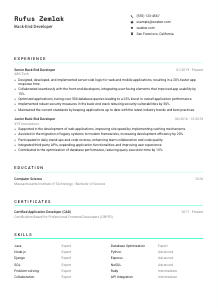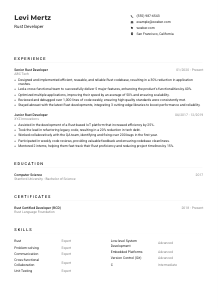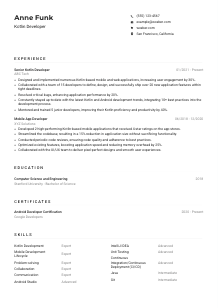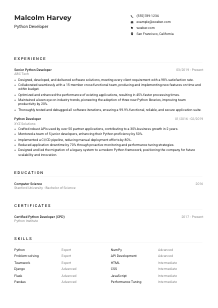Back-End Developer Resume Example
Weaving web wonders, but feel your resume is stuck in the front end? Dive into this Back-End Developer resume example, crafted with Wozber free resume builder. Unveil how effortlessly you can architect your back-end brilliance to meet job specifics, setting your career's server-side journey for optimal performance!
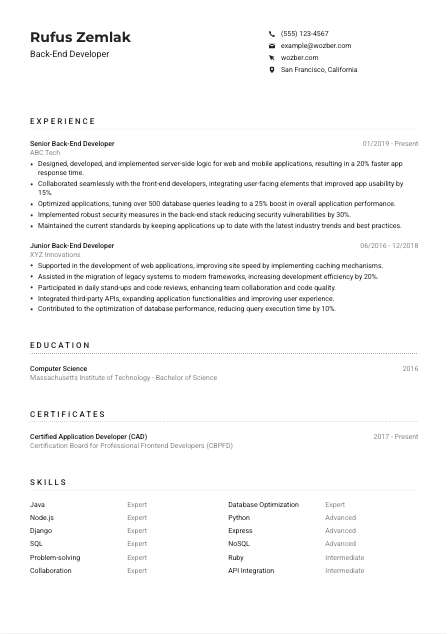
How to write a Back-End Developer resume?
Hello, aspiring Back-End Developer! If you're on a quest to stand out in the highly competitive tech landscape, you're in the right place. Your resume is more than a document; it's the narrative of your professional journey, a beacon illuminating your expertise and dedication. Thanks to the Wozber free resume builder, this guide equips you with the craft to sculpt a resume that not only matches but surpasses the job description's needs.
With our specialized tools like the ATS-friendly resume template and ATS resume scanner for keyword optimization, crafting an ATS-compliant resume is within reach. Let's embark on shaping your back-end expertise into a compelling story, positioning you for your dream role!
Personal Details
The Personal Details section, though seemingly straightforward, serves as your introduction to potential employers. Tailoring this section for a Back-End Developer position is crucial, ensuring accuracy while aligning perfectly with the job requirements. Here's how to make every word count.
1. Your Professional Name Tag
Your name is the first thing an employer notices. Ensure it stands out with a clear, readable font, making it slightly larger than the rest of the text. It's your professional name tag - make it memorable.
2. Job Title Precision
Immediately below your name, align your job title with the one you're applying for. If the job description says 'Back-End Developer', that's what should be right there, giving you instant relevancy.
3. Essential Contact Info
Include your most accessible phone number and a professional email address, ideally in the firstname.lastname@email.com format. Precision here is key to ensuring you're easily reachable.
4. Location Affinity
"Located in San Francisco, California" – if this matches your details, highlight it. It reassures your employer of no relocation hassles, making you a logistically attractive candidate.
5. Web Presence
If relevant, add your LinkedIn profile or personal website. This adds depth to your application, allowing employers to explore your professional persona further. Just ensure it mirrors your resume for consistency.
Takeaway
Crafting the perfect Personal Details section sets the stage for a stellar first impression. Consider it your business card within the resume, succinct yet packed with all you need to greet your potential employer. Keep it professional and aligned, and you'll pave the way for the rest of your resume to shine.





Experience
The Experience section is where you illustrate your journey and achievements as a Back-End Developer. Crafting this section to reflect your fit for the position is critical. Let's navigate through tailoring this segment to echo the provided job description, making it impossible for employers to overlook your prowess.
- Designed, developed, and implemented server‑side logic for web and mobile applications, resulting in a 20% faster app response time.
- Collaborated seamlessly with the front‑end developers, integrating user‑facing elements that improved app usability by 15%.
- Optimized applications, tuning over 500 database queries leading to a 25% boost in overall application performance.
- Implemented robust security measures in the back‑end stack reducing security vulnerabilities by 30%.
- Maintained the current standards by keeping applications up to date with the latest industry trends and best practices.
- Supported in the development of web applications, improving site speed by implementing caching mechanisms.
- Assisted in the migration of legacy systems to modern frameworks, increasing development efficiency by 20%.
- Participated in daily stand‑ups and code reviews, enhancing team collaboration and code quality.
- Integrated third‑party APIs, expanding application functionalities and improving user experience.
- Contributed to the optimization of database performance, reducing query execution time by 10%.
1. Decode the Job Description
Begin by dissecting the job description. For instance, 'Designed, developed, and implemented server-side logic for web and mobile applications' directly addresses a key responsibility. Highlighting experiences that mirror the job requirements is vital.
2. Structure and Detail
Chronologically list your roles, starting with the most recent. Detail each position with the job title, company name, and employment period. This linear structure makes your professional growth easy to follow.
3. Achievement-Focused Statements
For each role, craft statements emphasizing your achievements and responsibilities akin to those listed in the job description. Statements like 'Optimized applications, tuning over 500 database queries leading to a 25% boost in overall application performance' speak volumes.
4. Quantify Your Impact
Whenever possible, quantify your achievements. Numbers provide a tangible sense of your impact, making your accomplishments all the more impressive and believable.
5. Relevance is Key
Focus solely on experiences that are directly relevant to the Back-End Developer role. This isn't the place for unrelated achievements, no matter how tempting it might be to include them.
Takeaway
A meticulously tailored Experience section is the heart of your resume. By aligning your professional journey with the job description, you not only demonstrate your qualifications but also your potential to excel in the role. Approach it strategically - your career narrative is compelling, let it speak for you.
Education
While straightforward, the Education section is another opportunity to align with the job. Having the right educational background for a Back-End Developer is essential. Let's finesse this section to reflect your qualifications, resonating with the job description's demands.
1. Meet the Educational Criteria
Firstly, ensure your education matches the job's requirements. A "Bachelor's degree in Computer Science, Information Systems, or a related field" is specified, so mention it if you've got it. It's about meeting the baseline.
2. Simple, Clear Structure
List your degree, field of study, the institution, and graduation date in a clean, straightforward manner. Clarity here ensures easy scanning for HR managers and ATS alike.
3. Echo the Job's Language
Tailor your degree details to echo the job's language. For our example, stating 'Bachelor of Science in Computer Science' directly matches the job's educational requirement, creating a clear connection.
4. Relevant Courses, If Applicable
If you're in the early stages of your career or the role is specialized, listing relevant courses can be beneficial. It's about highlighting the breadth and depth of your knowledge in back-end development.
5. Highlight Academic Achievements
Include significant academic achievements or projects, especially those that align with Back-End Development. This could further demonstrate your passion and capacity for the role.
Takeaway
The Education section is not just a formality; it's an affirmation of your foundational knowledge, crafted to resonate with the employer's requirements. Showcasing the right educational background can significantly bolster your candidacy. Let your education do more than tick a box; let it underscore your readiness for the Back-End Developer role.
Certificates
In the ever-evolving tech field, certificates are solid proof of your dedication and expertise in specific areas. Even though the job description might not explicitly require certifications, showcasing relevant ones can set you apart. Let's explore how to feature your certificates effectively.
1. Align with Job Needs
Though the job description may not specify needed certifications, aligning yours with the role's demands can be impactful. For Back-End Developers, certifications related to Java, Python, or framework expertise, like Node.js, are highly relevant.
2. Prioritize Pertinence
Listing certifications that resonate with back-end development communicates your specialized knowledge. It's about quality, not quantity. Make every certificate count.
3. Be Current
Ensure your certifications are up-to-date, and if there's a validity period, note the date of acquisition. This showcases your commitment to staying current in your field – a key trait in the tech industry.
4. Continuous Evolution
The tech industry doesn't stand still, and neither should you. Regularly updating your certifications and pursuing new ones – especially those that align with your career aspirations – speaks volumes about your dedication to professional growth.
Takeaway
Strategically selected certifications demonstrate your commitment to professional development and back-end expertise. They add another layer of credibility to your resume, signaling to employers that you're not just suitable for the role, but passionate about staying at the forefront of technology.
Skills
Your Skills section is a concise showcase of your Back-End Development proficiency. It's where you list the technical and soft skills that make you an ideal candidate for the role. This segment requires thoughtful curation, ensuring relevance and impact. Let's delve into maximizing its potential.
1. Extract from Job Description
Begin by identifying the skills mentioned in the job description. Phrases like 'Strong understanding of database technologies including SQL and NoSQL' should guide you to list 'SQL' and 'NoSQL' as skills.
2. Relevant Skills First
Your list should reflect a blend of hard and soft skills pertinent to a Back-End Developer. For instance, include programming languages you're proficient in, followed by skills like 'Problem-solving' and 'Collaboration', directly mirroring the job's requirements.
3. Clear, Organized Listing
Resist the temptation to list every skill you've ever acquired. Focus on those most relevant to the job at hand, thereby crafting a list that's both digestible and tailored directly to your potential employer's needs.
Takeaway
The Skills section is your opportunity to align your professional capabilities with the job requirements. Each listed skill is a pledge of the value you'd bring to the role. Approach it thoughtfully, showcasing a strong blend of technical proficiency and the soft skills that make you an ideal team player. With each skill you list, you're one step closer to proving you're the perfect fit for the role.
Languages
In today's globalized world, being multilingual can be a significant advantage, showcasing your versatility and ability to communicate in diverse settings. For a Back-End Developer, proficient communication, especially in English, is paramount. Let's unpack how to present your linguistic abilities.
1. Check Job Language Requirements
Review the job posting for any specific language prerequisites. The ability to 'write clearly in English' is a must, highlighting English as a top-listed language.
2. Prioritize Job-specific Languages
Start with the language specified in the job description, then list any additional languages. Even if other languages are not required, they showcase you as a culturally aware and diverse candidate.
3. Accurately Rate Your Proficiency
Being honest about your language proficiency is essential. Terms like 'Native', 'Fluent', 'Intermediate', and 'Basic' clearly communicate your level of proficiency to potential employers.
4. Consider the Role's Scope
For roles with a regional or global scope, or involving diverse teams, your multilingual capabilities become an asset. Even if not explicitly stated, your language skills can broaden your appeal as a candidate.
5. Continuous Language Learning
Languages are a tool for connection. Regardless of the role, enhancing your language skills benefits your personal and professional growth, making you a more versatile and adaptable candidate.
Takeaway
Your proficiency in languages, particularly in English for Back-End Developers, marks your capability for clear communication, a critical component in collaborative environments. Presenting your linguistic skills, even those not specifically required, depicts you as a global-minded professional, poised to interact in diverse settings. Embrace your linguistic skills as invaluable assets, and let them underscore your readiness for the role.
Summary
Your Summary is where you encapsulate your professional identity, setting the stage for what's to follow in the resume. For Back-End Developers, this means highlighting technical skills, experience, and the unique impact you've made. Here's how to refine your summary into an engaging and succinct introduction.
1. Grasp the Job Essence
Absorb the job requirements. Understanding the core needs of the role allows you to tailor your summary to speak directly to those points, ensuring a strong start.
2. Start with a Bang
Begin with a strong opening statement that defines you as a professional. 'Back-End Developer with over 6 years of experience' immediately sets the tone and establishes your expertise.
3. Highlight Key Skills and Achievements
Briefly mention skills and achievements that align with the job's requirements. This might include your proficiency in specific programming languages or frameworks, as well as tangible impacts you've made, like boosting application performance.
4. Keep It Tight
Your summary should be concise, ideally 3-5 lines. It's an overview, not a detailed account. Aim to pique interest and encourage the reader to delve deeper into your resume.
Takeaway
The Summary section is your chance to make a memorable first impression. By strategically highlighting your skills, experience, and what sets you apart, you're signaling to potential employers that you're a strong fit for the Back-End Developer role. Treat it as your elevator pitch - tightly written, compelling, and reflective of your professional narrative.
Launching Your Back-End Developer Journey
You've now navigated the essential steps to tailor your resume for a Back-End Developer position, illuminated by the example crafted using Wozber's free resume builder. Remember, your resume is more than a list of accomplishments; it's a narrative of your professional journey. By ensuring each section is meticulously tailored to the job description and optimized for ATS with the Wozber ATS-friendly resume template and ATS resume scanner, you're well on your way to securing your dream role. Your expertise in back-end development deserves the spotlight.
Let Wozber be the tool that helps you shine. Dive in, start crafting, and turn your career aspirations into reality!

- Bachelor's degree in Computer Science, Information Systems, or a related field.
- Minimum of 3 years of experience in back-end development using languages such as Java, Python, or Ruby.
- Proficiency in using frameworks such as Node.js, Express, or Django.
- Strong understanding of database technologies including SQL and NoSQL.
- Effective problem-solving skills and ability to work in a collaborative team environment.
- Must have the ability to write clearly in English.
- Located in San Francisco, California.
- Design, develop, and implement server-side logic for web and mobile applications.
- Collaborate with front-end developers to integrate user-facing elements with server-side logic.
- Optimize application performance by tuning database queries and ensuring efficient data storage.
- Implement security and data protection measures in the back-end stack.
- Stay up to date with the latest industry trends and best practices to ensure the applications are in line with current standards.





